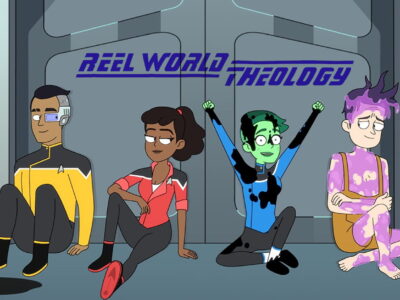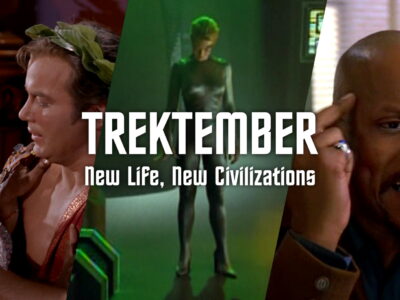Trektember: Trials and Tribble-ations
The original Star Trek was sometimes over-dramatic, but it was always dramatic. It was aiming for a kind of weighty seriousness, a sense that things really mattered; except in “The Trouble with Tribbles.” Then they just had fun, even poking some at the show’s main characters. The Deep Space Nine episode likewise tries to be a light comedy. While the “fan service” jokes don’t really fall very well, the humor that comes naturally out of the characters is pretty good. For instance, when Captain Sisko tells the temporal police officers at what stardate they arrived back in time, one of them dashes off the number of years, months, and days ago it was; and the other casually confirms, “A Friday.” I always forget that, and it never fails to amuse.
It’s interesting how people look back at entertainment from the past and assume that things looked fine back when they came out, even if they don’t quite look, feel, or sound right today. I used to think that of the science fiction movies I would watch on television, for instance; early ones from the 50s, where in some cases the effects were pretty bad: spaceships on strings and the like. I figured that was probably good enough for the time, but we had all grown past it thanks to Star Wars (or really 2001: A Space Odyssey). But bad special effects always looked bad. Star Trek V‘s effects, for instance, were embarrassing from day one.
In this episode, when our Deep Space Nine heroes first see the starship Enterprise, it’s an obvious updated model of the 1960’s ship. And when I say obvious, I mean it was obvious at the time. No one watching this episode thought, “Well, that’s the first time that ship has actually looked real.” But nonetheless, what really stood out to me was how the special effects team had recreated, at a then current level of effects, the same shots, ships, and space images that were done 30 years before. The simplistic spaceship designs are still there, but rendered as if they were in 1996. I knew these were visual effects, but I was more able to accept what I was seeing because I was used to that look; and it was kind of great! It’s like Tron. Nothing in Tron looks real, but Tron looks wonderful! Colorful, geometric, artful… The stylistic simplicity of this episode bypassed my downgrade filter and gave me the ability to see the old episode as if it were current; to imagine what it must have been like for a person in 1967 to watch the original “Trouble with Tribbles.”
It’s funny how time can change our perspective on a lot of things. For example, when Star Trek IV: The One with the Whales came out, I thought was a bit of a cop-out. One of the things I loved in Star Trek movies was the beauty of space on screen. It’s most notable in Star Trek: The Motion Picture, but beauty and glory of the deliberately gorgeous effects was something I got only once every two to three years, a movie that took place in the space where things were big and lovely. And the new Star Trek was going to cop out and take place on present-day Earth? Ho hum.
Fortunately, the movie had a lot of character, and its humor worked pretty well. It stands the test of time, and has even improved because now the movie is over 30 years old, and those widescreen shots of 1980’s San Francisco look like the past to me, much as they do to our Star Trek characters. It feels otherworldly in a way it didn’t before.
Now think about the Next Generation and Deep Space Nine era. They had things like touch screens. That was neat science fiction, even though it was clearly just plastic sheets with light behind them. They didn’t actually respond or do anything, but the concept that you could just touch a piece of glass and it would know where you were touching it, and what you wanted it to do—no buttons—that was out of the realm of possibility, even 15 years ago!
Or how about the communicators in 1960’s Star Trek, the flip-phone style. Well, those weren’t a thing yet in the 90s; so in Deep Space Nine we see our heroes suit up in the old style uniforms and then they break out old style communicators, the kind you have to hold in your hand. I can imagine them thinking, “Look at this old technology,” one of those Star Trek-isms where they refer to something that is in our future as if it is in their past.
Only now those are in our past, too! Flip phones are now old for us, so now I can watch this and see how it might seem old to them, feel how it might feel old to them.
“I remember this time. I lived in this time, and it’s hard not to want to be a part of it again.”
—Dax, giving the most obvious pull quote I could have used in this article.
Where does the impulse to idealize the past come from, or for that mater the impulse to idealize the future? What drives us to initially conceive of the time periods that we’re not in, or perhaps the lands and places were not in, as unproblematic? It’s kind of our default starting point. In the future all of our problems will be solved and there will be no money. Or back in the past everything was so much more simple, they didn’t have all the things to deal with that we do.
It’s really quite myopic. In fact it was considered a bit of a leap forward when someone finally invented a future where things were still complex, messy, imperfect. The impulse to glorify other times is deep enough within us that we have to fight it consciously, and with great effort.
Christians probably know what I’m hinting at. Obviously, it’s an impulse for Heaven. It’s the fact that, at a very very deep level, we both look forward to and miss an undefiled creation. It’s what compels us to restore things (old effects, in this example). It compels even those who don’t count themselves as believers in God to try to reform the world, make it better, less complicated, less aggressive, less insidious. That impulse comes from somewhere.
Evolution doesn’t do a very good job of explaining it. Evolutionarily, brutality preceded a good meal. If evolution has so much to say, then brutality is ingrained in us to be intertwined with pleasure. We should be more like the Klingons, conquerors, trying to be the strongest, because the strongest survive. The notion that things should be better, the deep belief that they actually could be better, too, is a motivator for most of us; whether we aim it inwardly or outwardly.
And sometimes when we look back at (or even remember) the past as if it was less complicated, nicer looking, more lively or whatever, we don’t necessarily have to delude ourselves into going along with it. Pull at that thread, and we would say, “No, of course they didn’t have altogether carefree lives then.” But that’s not why we’re engaging with it, because we believe it was idyllic; it’s because it should have been that way. It could have, too, and for some of us, one of the things we know about our future is that Heaven is a place where things work right, and look nice, and are complex like a great puzzle without being complicated like a great frustration.
We are tapping into a heavenward impulse.







Pingback: Trektember: Season 4 Episode List | Reel World Theology